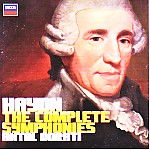Granted, there are better individual performances of the various symphonies from conductors as diverse as Eugen Jochum, Leonard Bernstein, Trevor Pinnock, and Thomas Fey; but when all is said and done this remains the finest complete set of Haydn symphonies yet recorded, and its basic musicality only seems to grow more impressive over time. Consider the early works: the period-instrument folks have had their say, especially in this music, but where will you find more clearly etched bass lines (Symphony No. 16), finer horns and timpani (finale of Symphony No. 13, based on the same tune Mozart later used in the finale of the “Jupiter” Symphony), or a harpsichord continuo that stays in the background and doesn’t flatten Haydn’s dynamics by turning each symphony into a keyboard concerto?
Just listen to Dorati’s band rip into the opening of Symphony No. 48; hear the wailing oboes at the start of the “Farewell” Symphony; or notice the intense string playing in “La Passione”. Where will you find a more rustic trio of Symphony No. 88’s minuet, such brilliance from the C-alto horns in Symphony No. 90, or a more consistent set of “London” symphonies? Bottom line: you won’t. Yes, there are some quibbles. The minuets tend to be slow by modern standards, and the engineering is somewhat inconsistent. In some of the more unfamiliar works the orchestral playing isn’t as fine as we now expect as a matter of course, but then Dorati surprises us with, say, his knockout performance of the six-movement Symphony No. 60.
The competition in complete cycles also isn’t terribly strong. Naxos’ complete cycle has some super individual efforts from a wide range of performers, but is weakest in the late works, just where it needs to excel. Nimbus (also Brilliant Classics) has some lovely volumes in its complete edition, but often sounds as if it were recorded in an echo chamber, (again) it’s weakest in the “London” symphonies, and certainly the playing does not surpass what we have here.
By rights this set never should go out of print: it remains a landmark in the history of recordings, and if you don’t have it this very reasonably priced limited edition becomes a mandatory acquisition. Get it while you can, and do what I did: put it on your iPod and you’ll never lack for a wonderful discovery. You can take it with you. [3/27/2009]
































